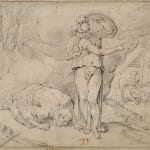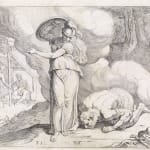
Theodoor van Thulden ('s-Hertogenbosch 1606 - 1669)
Minerva and Odysseus on Ithaca
etching and engraving
191 x 254 mm (plate)
Rijksmuseum Amsterdam, object no. RP-P-OB-66.762
Theodoor van Thulden ('s-Hertogenbosch 1606 - 1669)
Thedoor van Thulden was born in 's-Hertogenbosch in 1606, the eldest of nine. His father was a silversmith. At age fifteen van Thulden went to Antwerp, where he studied with the little-known portrait painter Abraham Blyenberch. In 1626 he became a member of the Antwerp guild of St Luke; he would be its dean in 1639 and 1640. Although he was never a pupil of Rubens, he was greatly influenced by his work and collaborated with him on several occassions, notably on work for the Torre de la Parada in Spain in the years 1636-38. Between 1631 -33 the artist stayed in Paris, where he copied Primaticcio's and dell'Abate's frescoes at Fontainebleau, which he also engraved. In 1635 van Thulden married Maria van Balen, the daughter of the painter Hendrick van Balen. Their daughter Maria Anna was born in 1636.
In 1635 van Thulden collaborated on the decorations for the Joyous Entry of the cardinal-infante Ferdinand, a project overseen by Rubens. He was also asked to produce the engravings for a commemorative book, the Pompa Introitus Ferdinandi, which was only published in 1642 and caused him considerable financial losses. Plagued by money worries, he went back to his native 's-Hertogenbosch in 1644, where he would remain for the rest of his life.
Van Thulden mostly painted history pieces and mythological scenes, and was one of the best decorative painters of his time. Stylistically, the mannerist influences from his early career were soon replaced by Rubens' baroque style idiom. From the 1640's onwards, he developed more of a personal style, which was more elegant and classicist. The present drawing dates from his time in Paris, ca. 1632-33, as it was copied after Primaticcio's fresco cycle in Fontainebleau depicting scenes from the Odyssee. (Les Traveaux d'Ulysse, the resulting series of etches, was published in Paris in 1633.)
The drawing, which is inverse to the engraving (see illustration), depicts Minerva lifting the mist to show Odysseus he has finally reached home, on Ithaca. Grateful and ecstatic, he flings himself to the ground and kisses it. Later on, Minerva disguises him as a vagrant, so he will not be recognized until the time is right. To the right, the disguised Odysseus is already on his way, visiting the swineherd Eumaios. A very similar drawing, depicting Odysseus regaling Penelope with the stories of his adventures, is in the Crocker Art Museum in Sacramento, CA. (inv./cat.nr E.B. Crocker Collection 1871.940).
Provenance
Private collection, France.
- X
- Tumblr
-
 Theodoor van Thulden ('s-Hertogenbosch 1606 - 1669)The Triumph of the Virgin Maryoil on canvas114,5 x 85,5 cmsigned and dated 'T. van Thulden fec AE 1663', lower left
Theodoor van Thulden ('s-Hertogenbosch 1606 - 1669)The Triumph of the Virgin Maryoil on canvas114,5 x 85,5 cmsigned and dated 'T. van Thulden fec AE 1663', lower left -
 Theodoor van Thulden ('s-Hertogenbosch 1606 - 1669)The Lamentation; a Design for a stained-glass Windowpen and ink over black chalk on 5 sheets on laid paper195 x 55 mm x 5
Theodoor van Thulden ('s-Hertogenbosch 1606 - 1669)The Lamentation; a Design for a stained-glass Windowpen and ink over black chalk on 5 sheets on laid paper195 x 55 mm x 5 -
 Theodoor van Thulden ('s-Hertogenbosch 1606 - 1669)The Lamentation: a Design for a stained-glass Windowpen and ink over black chalk on 5 sheets on laid paper195 x 55 mm x 5
Theodoor van Thulden ('s-Hertogenbosch 1606 - 1669)The Lamentation: a Design for a stained-glass Windowpen and ink over black chalk on 5 sheets on laid paper195 x 55 mm x 5




